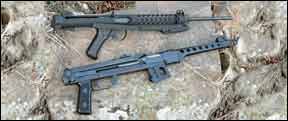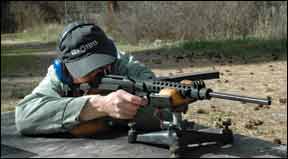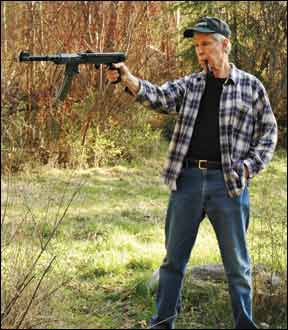We acquired two historical and technically interesting firearms for this test. The guns were the 9mm Wise Lite Arms Sterling L2A3 9mm, about $500, and the Inter Ordnance/Pioneer Arms PPS-43C Pistol chambered in 7.62×25 Tokarev, also in the $500 range. The latter is officially a pistol because its folding stock is welded in the folded position. We found the folding stocks do nothing for their handling or practical function, but in close quarters that might be a handy feature. Both designs originally fired from an open bolt, and the Sterling was originally selective fire. These two test guns are both manufactured to fire semiauto-only, and they both fire from a closed bolt. We managed to find three types of 9mm ammo and two brands of 7.62×25 Tokarev, enough to wring out both guns. Here’s what we found.

Wise Lite Arms Sterling L2A3 9mm Luger, $500
The Sterling was a well-made piece of goods, we thought. It had black crackle finish on all its metal surfaces except for the trigger group, which was Parkerized. The receiver’s mag well was marked “STERLING SMG 9MM MK4 (L2A3).” Barely visible through the crackle finish on the side of the action tube was “Wise Lite Arms Boyd, TX, Mod. S/A Sterling Sporter Cal 9mm.” The two magazines we received with the gun each held 34 rounds and were the original design, with rollers instead of a simple follower to ensure the rounds feed easily and positively.
The gun had an aftermarket barrel of just over 16 inches length that kept the Sterling legal, in keeping with its semiautomatic firing operation. Everything but the pistol grip was made of steel, pierced, welded, formed, and homogenized into an example of fine British gunmaking worthy of the Crown. The folding stock was a prime example. It was kept forward by one latch made from the swinging buttplate. Undo that and swing the stock rearward, but it won’t latch into place until you push the takedown cap forward, and you can’t do that until you press a second catch under the main tube. Then, to deploy the buttplate you lift it and pull it downward until two extensions dovetail into two notches and a third catch grabs it. When the stock is locked in place there is no motion, no slop, no wobbling at all. We found it gave the gun a solid feel. To refold the stock, you had to find all three latches and work them in reverse. With the stock folded, there was again no rattling or slop anywhere.
Inserting and removing the intricate, beautifully made magazines also showed the precision with which this gun was made. It’s no wonder it got such a good reputation and is apparently still in use in some corners of the world.
The rear sight was well protected. It was an L-shaped folding aperture with a large hole for 100 and a smaller one for 200 yards. We found that the smaller one was the correct elevation for the height of the front blade, but we had to move the front sight left to get the hits centered. It simply slides in a dovetail. Elevation is controlled by an Allen screw that locks the threaded front blade. To adjust height you loosen the Allen screw and turn the front blade in or out. We left it alone, but would turn it in if we owned it to get the strike a bit higher for both rear apertures.

Getting the gun apart for cleaning was simple once you knew the trick. With the stock folded, you have to push the bottom stock catch hard, fully in, and then shove the rear cap inward hard and turn it counterclockwise until it stops, and then everything comes out the back. The mainspring is under some tension, so be careful and ease the cap off. The firing pin looked like the tiniest part among some very hefty parts, and reports are that it has broken in some guns, but this one served us well. Still, we’d like to see it have about twice its current diameter. Then it would be in keeping with the other hefty parts. Everything else inside this remarkable gun was well made, stout, and looked to be more appropriate for a tractor than for a shooting instrument. Getting the takedown cap back on can be tricky. Wear safety glasses! It’s all too easy, when compressing all those in-line springs, to lose control of what you’re doing and have parts fly across the room at great velocity. Been there. Done that.
On the range we found the gun shot way left and somewhat low with the larger 100-yard aperture turned up. We drifted the front sight left to bring the hits back to center and then used the smaller 200-yard aperture to get just about centered. We didn’t touch the front sight. The trigger pull was long and smooth, and generally very nice. The accuracy was better than original specs, which called for all hits in 12 inches at 100 yards, or 6 inches at 50. Our best group at 50 yards was 1.4 inches for three shots, but most were around 3 inches on average.

Our Team Said: We thought this was a fine arm, well worth the price and useful for perhaps home security (watch that firing pin!), but most of all for fun at the range, and also as a valuable icon that shows what good gunmaking used to be. We thought it was a resounding A.
Pioneer Arms Corp PPS-43C Pistol 7.62×25 Tokarev, $500
First designed as a Soviet SMG, this gun was adopted by Poland during WWII and in one form or another was made in about 2 million copies. Our test gun was a joint effort by Inter Ordnance, Inc. (IOInc.us), and Pioneer Arms, and was converted to fire semiautomatically only, from a closed bolt. All the parts and pieces are new, and made at the old Radom plant in Poland. The folding stock is welded to the top of the receiver and the stock latch at the rear is also non-functional, so it’s not really possible to use the stock. More’s the pity, because we found this, as it was, to be among the most clumsy and near-useless firearms we’ve tested.
This oddity was classed as a handgun, and if you like the long-barrel Thompson/Center “handguns” you might like this one. However, you can’t simply strap on a scope and go hunting with this gun. It is fitted with crude iron sights that were miles off for us, with no reasonable way to put them on line that we could find. This gun was mostly stampings, very nicely done but with some sharp edges here and there. It had a plastic pistol grip, a curved 35-round magazine (four come with the gun, and also a cleaning kit), and smooth, even bluing everywhere but on the huge bolt. The gun had a safety in the form of a plate of steel in front of the trigger guard that slid upwards and rearwards to the On position. It locked the bolt and the trigger. As with the modified Sterling, there was no way to hold the bolt open.

Takedown was a snap. Clear the gun and leave the hammer cocked. Press inward (forward) on the latch at the rear. It’s the curved bit of steel that is the bottom-most piece at the very back of the gun. Hinge the gun open all the way, grasp the bolt handle and compress its spring slightly and withdraw the bolt and spring out of the gun. The spring comes out of its recess in the left side of the bolt. You now have three pieces, or four with the magazine. That’s it. The gun is easy to clean, easy to refit in the field, simple to get apart and back together again with no danger to your eyes — as with the Sterling. All in all, it’s a clever, simple, nice design that was well done and that worked very well.
Like the Sterling, the trigger pull was long and smooth, very usable. However, there was no good way to hold the gun. Two hands are needed unless you’re an Austrian-born governor of California and your first name is Arnold. Some of us don’t consider two-handed firearms to be handguns, but you and Arnold might. On the range we found it mighty hard to hold the gun steady with two hands, though the T/C crowd might do better than we did. From the bench, the magazine got in the way, and we had to prop up our machine rest about a foot to get target results. When we did, we got lousy groups with lousy ammo, but very decent ones with better ammo. Our best groups averaged 2 inches at 50 yards. The bad ammo gave us occasional failures to fire despite a stout whack on the primer, and groups of about 5 inches. Note that the barrel here is less than 10 inches long yet the bullets come out at 1800 fps.
Our Team Said: It’s a pity the stock isn’t useful, because if it was, this would be a great gun. Still, we can’t downgrade it just because we can’t hit with it and don’t like its handling qualities. It’s undoubtedly on the awesome side for intimidation when being held at the hip for close-range point shooting, and that might be valuable to you. Those familiar with the type might be right at home holding and hitting with two arms and no shoulder support. But the gun hit a full 12 inches high at 50 yards for us, so that’s got to be dealt with before it gets a higher grade. We called it a B, and with a real stock (and of course a legal-length barrel, which would ruin its looks), it would be a solid A.
Written and photographed by Ray Ordorica, using evaluations from Gun Tests team testers.



























